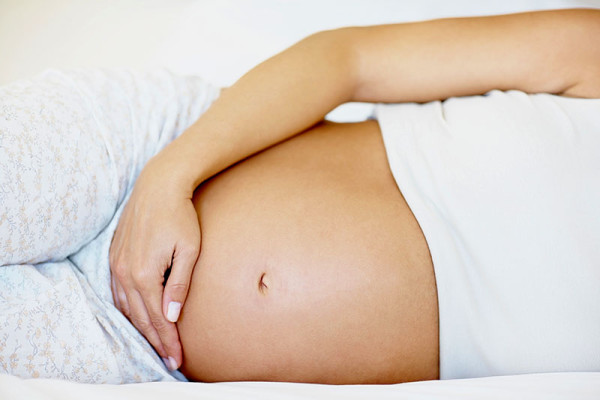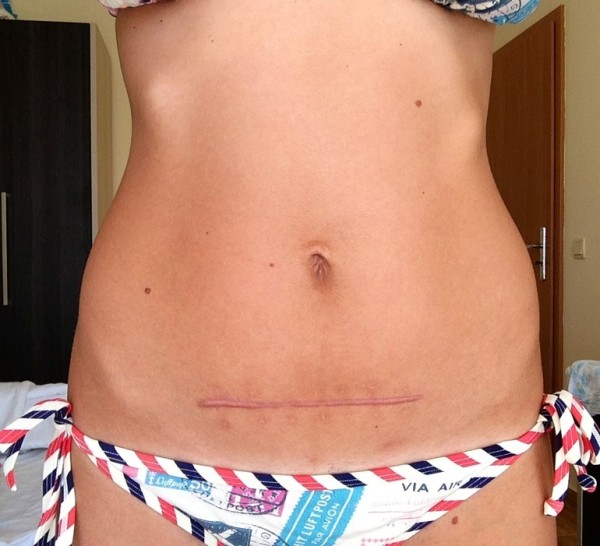Caesarean section: how and when to do, recovery, reviews
The happiest day in the life of every woman is the one on which she becomes a mother. The feeling that a new man was born, who was carefully worn under his heart for 9 months, who needs love and care, is simply indescribable. And even the problems that often stand in the way of a pregnant woman are not able to darken this event. Some women, for various reasons, are not able to give birth naturally, so doctors, in order not to risk the life of both the baby and the mother, prescribe a cesarean section. In what cases this happens, how the operation is done, how the recovery takes place and much more - we will talk about all this today.
Content
- Indications for cesarean section
- How long does a cesarean section take?
- How is a cesarean section done?
- Caesarean section: pros and cons
- Abdomen after caesarean section
- Suture after cesarean section: photo
- Recovery after cesarean section
- What to eat after a cesarean section
- Sports after cesarean section
- Discharge after cesarean section
- Pregnancy after cesarean section
- Natural childbirth after cesarean section
- Sex after cesarean section
- Caesarean section: reviews
Indications for cesarean section
In practice, doctors are often faced with the fact that women in labor themselves want a cesarean section. Basically, this is due to the fear of pain that accompanies the process, and tales that it is with such births that the risk of birth injuries is significantly reduced. And, paradoxically, women who, for health reasons, are shown such childbirth, with all their might resist the procedure, trying to give birth to a baby naturally. After all, experiencing all the feelings of birth is incredibly pleasant.
Let's disappoint those who think that a cesarean section is a simple labor and does not cause any harm. Yes, the woman does not feel the process of childbirth at all and does not experience any pain. But then, when the anesthesia disappears, all the sensations are given out in bulk, so much so that some mothers cannot even move for several days. Caesarean section is a full-fledged operation, after which complications can also occur. A scar forms on the uterus, which can cause subsequent infertility or miscarriage... Of course, the risks are significantly reduced if the procedure is carried out in a good perinatal center and the business is done by professionals. Given this, asking for a cesarean section without evidence is not at all as advisable as it might seem at first glance. It is quite another matter when there is a medical indication for this.
So, here are the cases in which experts predict an operation in advance:
- Placenta adherence. If the placenta is located at the bottom of the uterus, then this threatens with severe bleeding at the time of natural childbirth, which increases the risk to the life of both the baby and the mother. The operation itself can be done at 38 weeks, and sometimes even earlier, if circumstances suggest that, for example, bleeding from the vagina is observed.
- Early detachment of the placenta, with its initially normal location. In the normal course of pregnancy, detachment occurs after childbirth. However, there are times when detachment occurs when the birth itself is still far away. The woman is bleeding, which also poses a threat to the life of the mother and baby, so an urgent operation is required.
- In cases where a scar from a previously performed cesarean section is recognized as insolvent. Such a title is awarded to him in the event that an ultrasound scan showed that the dimensions of the seam in thickness are less than three millimeters, the contours are uneven and there are other defects.
- If there are two or more scars on the uterus, then this increases the risk of rupture of the uterus at the time of natural birth, therefore, specialists also prescribe an operation some time before the planned date of birth.
- The woman in labor has a very narrow pelvis, which makes it difficult for the baby to exit naturally.
- Deformed pelvic bones and the presence of tumors are also an obstacle to natural childbirth.
- Tumors in the uterus, ovaries, pathology of the pelvic organs can simply block the birth canal.
- Large size of the fruit. Such a baby is considered with a weight of 4 kilograms or more.
- The presence of symphysitis in the future mother is the divergence of the pubic bones. But not always, with such a diagnosis, a cesarean is necessarily done. A radical measure is taken only if: the weight of the child is over 4 kg, the discrepancy is over 1 cm, severe pains and a narrow pelvis of the expectant mother are noted.
- Myoma of the uterus(multiple and large sizes).
- The presence of gestosis.
- Severe diseases of the heart, blood vessels, nervous system, diabetes mellitus, etc.
- Rupture of the birth canal III at the time of the previous birth in a natural way.
- Dilated veins in the vaginal area.
- Pelvic or transverse fetal adherence.
- Long-term infertility in combination with pathologies.
- The mother's age is over 30 years old.
- Postterm pregnancy.
- Cancer, regardless of where it is localized.
- Exacerbation of genital herpes.
The list is long, but these are far from all the reasons. The listed items imply the establishment of the date of the planned cesarean section. But it also happens that initially a woman planned to give birth naturally, but various kinds of problems force doctors to take emergency measures and perform a caesarean section at the time of the onset of contractions. So, at the time of delivery, a cesarean can be done if:
- the child cannot come out naturally, as interference is created by the narrow pelvis of the woman in labor;
- if the waters have departed, but the birth itself does not come;
- a woman cannot give birth for a long time, which begins to raise the risk of a baby's death;
- there are signs of baby hypoxia, which is determined by the frequent heartbeat of the baby, which does not stop;
- there is a prolapse of the umbilical cord - if the cesarean is not carried out urgently, then the child with a high degree of probability will die;
- improper adherence to the fetus.
There are many reasons why a cesarean section can be prescribed, but only a doctor decides to do an operation or to give birth naturally, after performing many tests. In order to avoid disastrous consequences - always listen to a specialist, because at stake is the question not only of your health and life, but also of your baby.
How long does a cesarean section take?
Caesarean section can be planned and urgent. As soon as it becomes clear that the woman will give birth by caesarean section, the specialist appoints the approximate date of the operation. But sometimes inconsistencies occur and contractions begin earlier than planned, and in this case, an urgent cesarean is organized.
In general, the terms are determined individually, but, as a rule, it is 39 weeks. If you have to carry out an urgent operation (when contractions occur) before this time, then the baby may have breathing problems. But such cases more often occur with repeated cesarean.
How is a cesarean section done?
Let's consider in general terms how the caesarean section is performed.
Preliminary preparation
First comes the preparation. A pregnant woman, as a rule, is placed in a hospital in advance in order to carry out all the necessary examinations, to understand that the child has grown up enough and is ready to be born. Most often, the operation takes place in the morning, so the last meal of the future mother should be no later than six in the evening on the eve of childbirth. This is done so that the stomach is empty in order to avoid food from entering the respiratory tract of the woman in labor. In the morning, all the necessary hygiene procedures are carried out: an enema, depilation of the pubis, dressing in special clothes. This is followed by transportation to the operating room. Before the operation, anesthesia is done, a catheter is inserted into the bladder (it is removed several hours after childbirth), the abdomen is disinfected and a screen is installed near the breast of the woman in labor so that the latter does not see anything.
Anesthesia with cesarean section
In terms of anesthesia, there is a choice: general anesthesia and epidural. The latter involves the introduction of a very thin tube through a needle into the exit site of the nerve roots of the spinal cord. It sounds creepy, but a woman feels unpleasant sensations literally within a couple of seconds, when the puncture itself occurs. Further, everything in the body below the waist is completely paralyzed. General anesthesia is applicable only in the most extreme cases, when doctors cannot wait for the first action. Here everything is as usual - intravenous administration of preliminary anesthesia, then anesthetic gas with oxygen is injected through the tracheal tube, after which a special drug is injected that relaxes the muscles.
Cesarean section
Once the anesthesia is fully effective, the doctors proceed with the operation. First, an incision is made in the abdomen. The incision is of two types: transverse (above the bosom) and longitudinal (from the bosom to the navel). The latter is made in emergency cases, when you need to urgently and quickly reach the baby. After that, the doctor spreads the muscles, makes an incision in the uterus and opens the fetal bladder. The baby is pulled out, after which the placenta is removed. The uterus is sutured with self-absorbable sutures, which disappear after a couple of months. Next is the abdominal wall. At the end, a sterile bandage is put on and, in order to help the uterus to contract more quickly, ice is applied, this also helps to stop the bleeding. The duration of the operation is about twenty to forty minutes, and the baby himself is born already at the tenth, and sometimes even earlier.
Within 24 hours after the operation, the young mother is in the intensive care unit, doctors carefully monitor her condition. After that, if everything is fine, the woman is transferred to the ward. To weaken the fate in the postoperative period, mom is given pain relievers and drugs that help the uterus to contract and normalize the work of the gastrointestinal tract.
If the operation itself went without complications, then the doctors allow the woman in labor to get up after six to seven hours. First, carefully sit down on the couch, and then stand a little. It is strictly forbidden to strain and do even the smallest physical activity, as this is fraught with seam divergence.
The expectant mother should buy a special bandage in advance, which will significantly alleviate the condition after the operation.
Caesarean section: pros and cons
Let's take a look at the main pros and cons of a cesarean section. Pros:
- In an operable birth, there are no trauma to the birth canal such as incisions and tears.
- The duration of the birth itself practically does not exceed forty minutes, while there are no contractions or attempts. While natural childbirth can last for hours, or even a day.
As for the cons, these are:
- Psychology - some mothers complain that they do not feel unity with the baby, there is no strong feeling that now they feel like full-fledged parents.
- Severe pain that comes after the passage of anesthesia.
- A scar on the abdomen that remains for life.
- There are more chances of complications, since a full-fledged surgical intervention occurs.
- For a month and a half, you cannot take a bath, only a shower.
- Lactation problems are common.
Abdomen after caesarean section
After a cesarean section, ladies are concerned about how to remove the belly. The process is complicated by the fact that for quite a long time all physical activities are prohibited. So, in order to get closer to the previous ideal and return a disagreeable appearance to the tummy, you can adhere to the following rules:
- In no case should you begin to work after cesarean earlier than two months later, in some cases it takes more time to recover. Before starting classes, be sure to consult with a supervising specialist. He will assess the current state and make recommendations. Even if the go-ahead is received, the loads should be started gradually.
- Even simple walks with a baby can be used as a way to get in shape. Walk in moderation but fast for about an hour a day. So you will "kill" two birds with one stone: the baby will breathe fresh air, and your muscles will sooner be toned.
- It is better to start physical activity with simple bends. You can do your day-to-day activities differently. For example, do not wash in a washing machine, but by hand; wash the floors not with a mop, but with your hands.
- As soon as the baby is older (about three to five months), start playing with him in such a way as to use the muscles. For example, lie down and put the baby on your chest and start lifting up a little. Thus, the press will sway and the baby will have fun.
- Observe proper nutrition. This will normalize the work of the gastrointestinal tract and not gain weight.
- Wear a bandage as it helps to speed up the process of shaping your belly.
Suture after cesarean section: photo
Recovery after cesarean section
After the operation, anesthesia is carried out for several days. In order to prevent blood stagnation, it is necessary to ensure the movement of the body: at first it will be coups on the bed, and then it is permissible to get up. 6-7 hours after the operation, you need to start therapeutic exercises, which the doctor will tell in detail about - this is stroking the abdomen, chest, lower back, etc.
Take special food, and you can go to a normal table only from the fourth day. Discharge from the hospital takes place, as a rule, only on the seventh day. By this time, it is permissible to take a warm shower with baby soap. Baths are strictly prohibited for two months.
Once you are discharged, it is very important that relatives take over all household chores while you are recovering. Bathing the baby, changing his clothes and other manipulations must be done so as not to bend over, therefore, it is welcome to acquire a high changing table.
The following are strictly prohibited:
- lifting weights, over four kilograms (if the child is pressed to the chest, then it can be carried);
- colds - therefore you need to dress warmer and take care of your health;
- sex life - until the lochia ceases to come out, which is about eight weeks.
After discharge, listen carefully to your doctor, who will definitely give recommendations for a speedy recovery, given your current condition. Coordinate any action with your gynecologist in order to avoid complications and disastrous consequences.
What to eat after a cesarean section
The doctors themselves advise the woman in labor. As a rule, on the first day you shouldn't eat anything at all, just drink water. All nutrients enter the body of a young mother exclusively through the injected drugs.
If the operation went off with a bang, then on the second day, broths, dietary meat (only boiled and necessarily mashed), various drinks (fruit drinks, juices, decoctions), cottage cheese and yogurt are considered acceptable.
The third day may include cutlets and meatballs from lean meat, porridge boiled in water, kefir, baked apples. Consult with a specialist about the subsequent nutrition in order to make it as complete as possible.
Sports after cesarean section
The introduction of sports into everyday life should take place very smoothly, but not earlier than after a couple of months. Always and always agree with your doctor. It is best to start with the usual morning exercises, which will tone the muscles. If you overdo it ahead of time, then the stitches on the uterus and abdomen can disperse, which will have disastrous consequences.
Discharge after cesarean section
In the first week after the COP, bright burgundy clots come out, these are lochia and this is normal. At the time of feeding the baby, the discharge may increase - this is also the norm, since the uterus contracts. Already on the fifth or seventh day, the discharge is significantly reduced and becomes, for the most part, smearing. Over time, they will lighten and acquire a slimy structure. In a healthy body, only leucorrhoea should be released after two months.
If the discharge is completely absent, you need to urgently consult a doctor, this may indicate a bend of the uterus or spasm, which provokes blood stagnation. Abundant discharge should also serve as a reason for treatment - this can be a signal of inflammation, especially when everything is accompanied by fever and poor health.
Listen to your body, in case of the slightest malfunction, do not think that "it will pass by itself" - be sure to go to the doctor. The recovery period after a cesarean section is a crucial period when you need to be very attentive to yourself and your health!
Pregnancy after cesarean section
One of the disadvantages of a cesarean section is that doctors do not advise planning a second pregnancy earlier than in two or three years. During this time, the body has time to rest, renew itself and come to a normal state. But who listens to doctors in practice? And in general, pregnancy is rarely planned by anyone, often it comes as a surprise from above. General and specific recommendations for planning subsequent pregnancies are given on an individual basis by doctors, who make a conclusion on the condition of the woman in labor.
Early pregnancy is fraught with negative consequences for both the child and the mother. The scar itself will not have time to heal and will be insolvent, which will lead to rupture of the uterus either during pregnancy or at the time of the birth itself. If, despite all the warnings, the woman nevertheless became pregnant, then, most likely, doctors will offer to have an abortion in order to prevent complications. And then only the mother herself can make a decision. In fairness, it should be noted that in practice there are known happy cases of bearing babies, whose conception occurred a month after cesarean. But these are rather exceptions, so you should not rely on luck, but make an informed decision.
In the very process of conception, problems can arise only in cases when the operation was carried out unprofessionally and doctors' mistakes were made, or in the presence of complications. In general, no matter how scary it may sound, after such an intervention, even infertility may occur, so carefully select the maternity hospital, since the birth certificate allows it.
Natural childbirth after cesarean section
Natural childbirth after cesarean is possible only in cases where the incision was performed in a classical way (horizontally), there were no operations on the uterus (except for the cesarean itself), there are no serious diseases, in the institution in which the birth is planned, highly qualified specialists work. It should also be understood that if there were several cesarean sections previously, then natural childbirth is highly discouraged.
In practice, doctors themselves rarely allow natural childbirth after the first cesarean. This is due to the risk that occurs in such situations. And, so as not to "play" with the life and health of the mother and baby, secondary and subsequent childbirth is organized in a manner similar to the first.
In any case, this is not a doctor's whim, but far from an unnecessary safety net, so you should not interfere with the actions of specialists and not stand your ground, no matter how you would like to give birth to a baby in a natural way.
Sex after cesarean section
After natural childbirth, the ban on sexual relations is quite logical, because the vagina needs to be restored. And what after cesarean? Following a caesarean section, similar rules apply. Many believe that since the vagina was not used during childbirth, it means that there were no injuries, therefore, sex can be as soon as the desire arises. But no!
Yes, the birth canal is unaffected, but. Firstly, even with KS, some time after discharge is observed, the cessation of which must be waited for. Secondly, the uterus was injured, now there is a scar on it, which must be healed. Sex is the same physical activity, albeit more pleasant, and at the time of orgasm, the uterus contracts. Such an effect on an organ that has not yet healed can turn out to be extremely unpleasant, up to the divergence of the seams!
Many are worried about sensations: whether they change; does it hurt? In fact, it is impossible to answer this question unequivocally, which is due to the peculiarity of the organism. Almost everyone speaks about unpleasant sensations, some even feel pains that do not go away for a long time. Hormonal changes are not predictable and can lead to different consequences. A common problem that entails pain during intimacy is the lack of natural lubrication, which is due to the "play" of hormones. As doctors say, you shouldn't panic about this, after the cycle is restored, everything returns to normal.
But in any case, it is better to consult a doctor who will give recommendations on the resumption of sexual activity.
Caesarean section: reviews
You should not take a cesarean section for an ordinary manipulation - this is a full-fledged operation, during which anything can occur. Therefore, the doctor and medical staff who will participate in the process must be highly qualified so as not to harm either the mother or the baby.
As for the reviews of moms, they are all different. On the Internet, you can find truly horrifying reviews, from which tears well up in our eyes, but, fortunately, there are many more happy stories. There are a lot of complaints in the postpartum period and terrible pains from internal and external stitches. Those women who, in addition to cesarean, had experience of natural childbirth, if possible, are not advised to choose a COP, but to give birth in a normal way. But often the type of childbirth is not chosen, but what is destined to be accepted.
Take care of yourself, easy, fast and successful childbirth and a healthy baby!
In the video, you can see in detail how a cesarean section occurs. This is truly unique footage of how, thanks to the professional actions of doctors, healthy babies are born and there are more and more happy mothers in the world.












